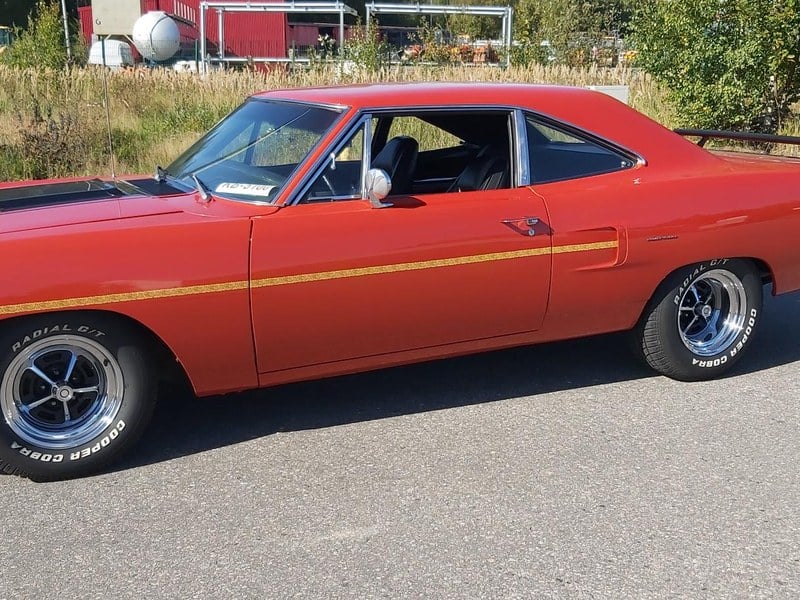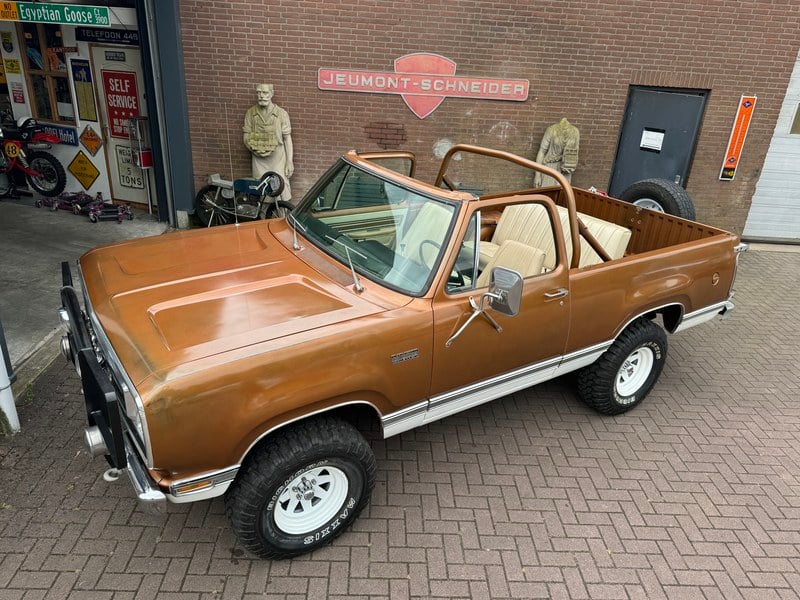Description
West Coast Classics are proud to present a rare and no expense spared fully restored example of this 1969 Plymouth Roadrunner with a date correct 426/ 425HP 2x4BBL V8 Hemi engine matched to a 4 speed manual transmission with bucket seats and a Dana 60 rear end. This Roadrunner was restored by Julius Restorations in Chatsworth Ca who recently relocated their business to Texas, as is not uncommon now in California! Reportedly this Roadrunner was an original California Car with zero rust.
The car was completely taken apart and a replacement Hemi engine block was installed with all other parts believed to be true to the car. The original block is not longer available. The car was stripped down to bare metal, removing all windows etc. The original fender tag was removed and replaced with a reproduction tag but the original is still available and will be sold with the car. The car was repainted in correct 'Scorch Red' as per the VIN fender tag with a 'Pewter' interior also reinstalled as per VIN. The restoration took approximately two years to finish in 2004, at which time the previous owner had purchased the Roadrunner.
Original Fender Tag decodes as follows:
08132 - Gate 8, 32nd car to enter that gate
175988 - Body in White number (BIW), 75, 988 car to enter the BIW area
9A159081 - 1969, Lynch road plant, 59, 081 VIN assigned.
921 - 9/ 21/ 1968
644 - Dana 60 Super Track Pak 4. 10 gears ratio with front wheel disc brakes, using 10" drum brakes in rear.
605 - Correct code for A833 4spd trans for 440/ 425 engines
26 - 26" radiator
1X - Black Vinyl Top
7X - Black painted Accent Stripe
N96 - 'Air Grabber' Fresh Air Hood (1969-71)
C16 - Console with woodgrain panel
R6 - 'Scorch Red'
R6 - 'Scorch Red'
M6S - 'Pewter/ Black'
A4 - Basic radio (1969-71)
V21 - Performance Hood Treatment (1969-71)
RM23 - Roadrunner 2 Door Hardtop
E74 - 426 Hemi 2x4BBL 425HP V8 engine (1969-71)
D21 - 4 speed manual trans (1969-71)
A30 -
This particular car decodes from its original fender tag and VIN as being an original 'J' code 426/ 425HP 4 speed Hemi car but please note does now have a date correct, but not its original matching #'s, 426/ 465HP Hemi V8 engine.
The 426 RB block was introduced to power the big and heavy Chrysler, Dodge and Plymouth intermediates and full size cars in 1964. This street Hemi engine was the ultimate big block after the 375HP 440 cid V8. Chrysler was heavily involved with racing at the time and the Max Wedge engines were doing well on the drag strip but they were not as competitive on the NASCAR circuits. The Wedge just could not breathe as well as their competitors and Chrysler knew that the reintroduced hemispherical combustion chamber cylinder heads for use on the 426 cid RB blocks was the best design for producing the most power. Rather than build a completely new engine from the ground up Chrysler chose to fabricate Hemi cylinder heads and use them on their existing RB engine block. The result was the 426 Hemi from which Chrysler built a great variety of Hemi-head engines starting in 1964-65.
The drag race Hemi engines were different from the circle track engines with each using different intake setups, internal components and with different displacements. The drag engines were offered in 415 & 426 HP versions whilst the circle track engine was rated at 400 HP with a single 4BBL carburetor. Chrysler first used the engine in the most prestigious NASCAR race of all - the Daytona 500. Hemi powered Plymouths took the first 3 positions in the 1964 race and although Ford won 30 races that year compared to Chrysler's 26, it was obvious that Ford's 427 Wedge days were numbered which resulted in Ford building its own Hemi engine, the 427 SOHC.
It should be pointed out that the 426 Hemi and other engines used in sanctioned racing were special, low production engines that were never really intended for use on any street vehicle. Indeed the engines were only produced for street cars after NASCAR ruled that if either Chrysler or Ford wanted to race their complex and expensive Hemi-head engines then they would have to build a certain amount of street cars with these motors and sell them first to the public. Ford famously declined but Chrysler went ahead and so the legendary 426 street Hemi was born in 1966. Ford eventually did build its own street hemi, the Boss 429, but not until 1969.
This particular car is the recipient of a full restoration with no expense spared and still boasts a date correct 426/ 425HP V8 Hemi engine with Hemi cast iron manifolds matched to a 4 speed manual transmission and Dana 60 rear end. The car looks very impressive in it's original 'Scorch Red' color and 'Pewter' interior.
The 426 Hemi V8 engine is extremely strong and powerful with only very few test miles since the build and this particular car drives like a dream, the 4 speed manual transmission shifts smooth and the engine temperature always runs cool. This is one very rare and highly desirable and collectible example of one of the outstanding muscle cars of the late sixties, which has high repute amongst collectors for both it's beautiful lines and simplicity and high performance.
For 1968, the Plymouth lineup offered the high performance Roadrunner packed with a standard 383/ 335 HP engine with an optional 4 speed transmission, heavy duty suspension, GTX like hood bulges, a 'taxicab' basic interior, little cartoon bird decals on the doors and the unique 'Beep-Beep' Roadrunner horn!
Combined with low weight, the 6-passenger Road Runner could run the 1/ 4 mile in 13. 5 seconds at 105 mph (169 km/ h). It would prove to be one of the best engines of the muscle car era, and the Road Runner one of the best platforms to utilize it. The Roadrunner was not fragile. Unlike some sports cars (such as the Corvette), it was built for serious street work, the Roadrunner was reportedly a favorite of moonshiners, faster than almost any police car and tough enough to take practically any bump, with good ground clearance to boot. Everything essential to performance and handling was beefed-up and improved; everything nonessential was left out. The interior was spartan, lacking even carpets in early models, and few options were available. A floor-mounted shifter featured only a rubber boot and no console so that a bench seat could also be used.
An "Air Grabber" option consisted of an air duct assembly bolted to the underside of the hood that connected to twin rectangular upward-facing scoops in the hood. When the hood was closed, a rubber seal fitted over a large oval unsilenced air cleaner assembly that ducted air directly into the engine. The scoops in the hood could be opened and closed via a lever under the dashboard. Continued only until 1970 and a 'Milestone classic car status' vehicle today!
With the four speed shifter, the acceleration is unreal! Because it was a bare-bones muscle car it's weight was kept as low as possible for an even better power to weight ratio than any of it's competitors. Plymouth needed a muscle car to really stand out from it's competition and with 335HP this car really lived up to it's name and could beat almost any other muscle car on the street, with the 440 6 Pack it was unbelievable, and with the Hemi it was both unbelievable and simply unbeatable!
Dodge missed out on these low priced muscle cars at the beginning of the 1968 season but soon added the Super bee to counterpart the Roadrunner. The Roadrunner and Super Bee's performance quickly silenced any laughter coming from those who drove an SS, GTO or GTA, names that began to sound dated. Lean and mean, meant for boulevard cruising or an occasional street race, these vehicles offered the Mopar buyer the ultimate bang for the buck and the proof was that the Roadrunner was Motor Trend's Car of the year in 1969! One of the standout muscle cars of the sixties, rare today, a neat original Roadrunner is highly prized by collectors and Mopar enthusiasts, yet alone one with the coveted Hermi 426!
In summary, this strikingly restored 1969 Plymouth Roadrunner with a 426 Hemi V8 engine matched most desirably to a 4 speed manual transmission and with bucket seats is one rare example of sixties muscle car excess, ready to drive and enjoy today and a sure-fire investment that's sure to appreciate over the years for any classic American sixties muscle car enthusiast or Mopar enthusiast!













